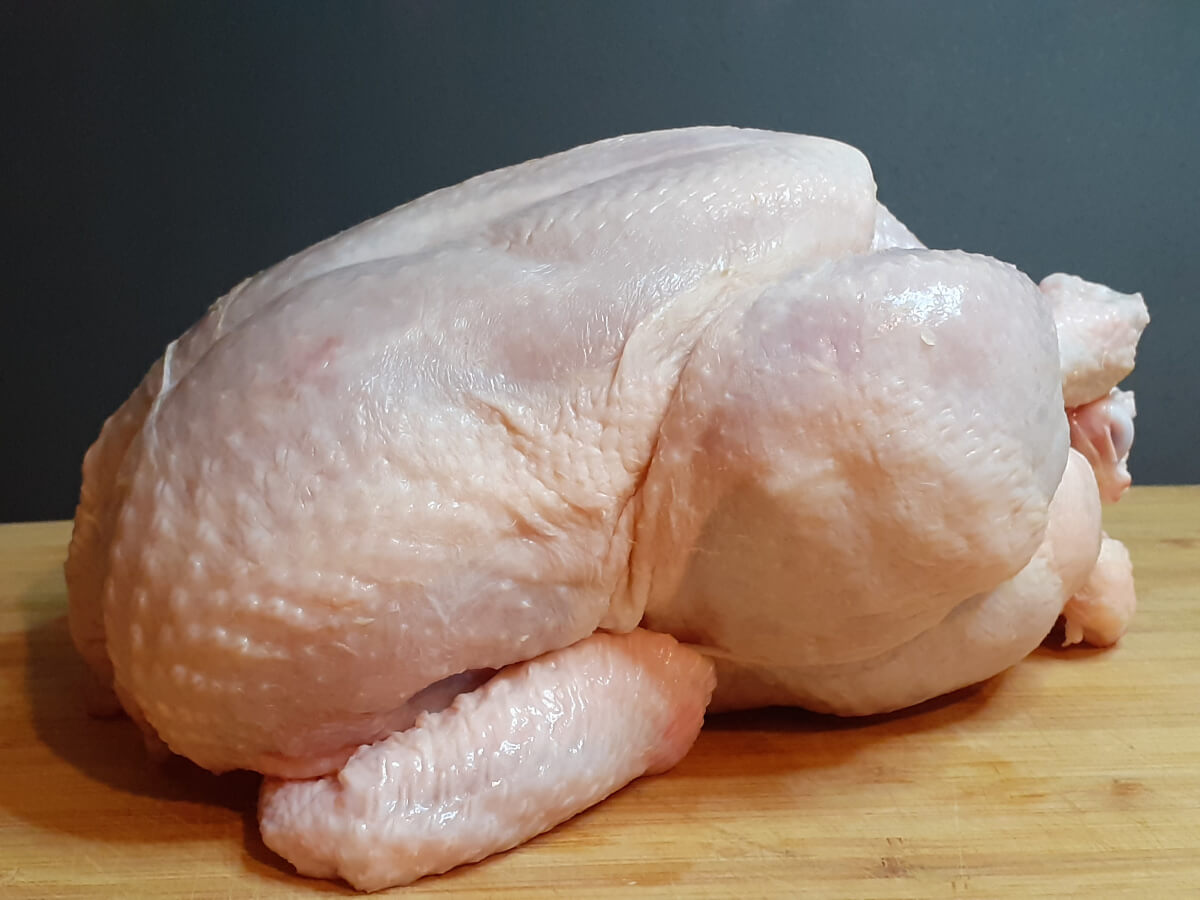
Learn how to prepare Chicken for different ways of cooking, or butchering a Whole Chicken into 8–12 pieces. How to extract blood from the Chicken so that it’s not in your final product or at the very least minimize it and to clean and trim Thighs, plus other useful tidbits of information.
Before we proceed, Food Safety Guidelines suggest not to wash your Chicken because it can spread bacteria through the splashing of water. Almost all infections however are caused by eating raw or undercooked Chicken or improper handling, and not necessarily the washing.
It’s your choice whether you want to wash or not. I normally don’t wash Chicken. Unless there are Thigh pieces or if I’m drawing blood out of the Chicken. I always wash afterwards to remove any excess salt, more on that below.
Whole Chicken
You start with a Whole Chicken that is usually tied with Butcher twine for easy roasting. If roasting the Chicken, nothing else needs to be done, besides seasoning the Chicken and removing the Neck. In some cases, a package of the internal organs can be in the cavity, which will need to be removed. But usually this is included for Turkey and not for Whole Chicken.
The Whole Chicken can be seasoned and placed on a roasting pan to cook as is, or on a rack to lift it a bit or on top of chopped Onions, Carrots & Celery. A 3-4 lb Whole Chicken will take about 1 1/2 hours to cook.

The Wing Tip can be bent back and folded under the Chicken to stay close to the whole Chicken and not overcook.
Rotisserie Chicken
If cooking a Whole Chicken, about 3 lbs in a Rotisserie unit, skewer the Chicken and keep in place with Rotisserie Forks. This is the tricky part with Home Rotisserie Units. They usually do not include a counterbalance and because of that you really need to skewer in such a way that the Breast are balanced against the Back Quarters to prevent the Chicken from jumping or skipping. Which will result in an uneven cook. Once you have the chicken skewered hold the two ends and rotate to check if it is balanced. If not, readjust and try again.
Oil and Season the Whole Chicken and set aside for 30 minutes or so before placing into the rotisserie unit to cook. Optionally, you can dry age the Whole Chicken by seasoning it and placing it on a rack to refrigerate for a day before taking it out to rest on the counter and placing into the rotisserie unit to cook.
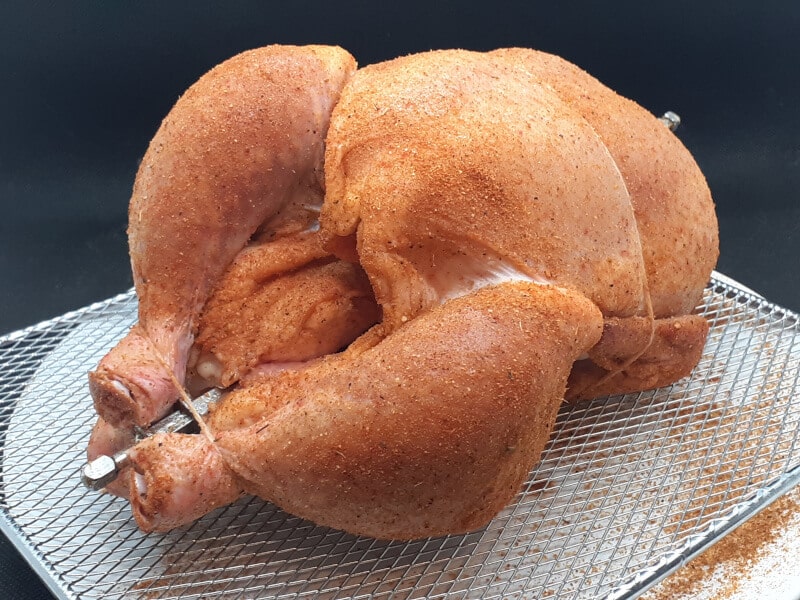
Butterfly Chicken
For a faster way to cook a whole Chicken, Spatchcock or Butterfly the Whole Chicken. This can be seasoned and laid out on a tray to cook at for about 45 minutes to 1 hour, depending on size.
Butterfly Chicken requires the backbone to be removed. Then the Chicken is laid down flat and the Breast is pushed down to flatten it out further. I like this method for a faster cook time in the oven or if I want the skin side up and seasoned very well. The below images are of Butterfly Turkey, but the same technique applies to whole Chicken.
Use heavy Shears to cut on each side of the backbone to remove it. Flip the Chicken Over and lay out flat. Then press down on the breast to crack it and flatten the Chicken out.
The backbone can be frozen and used for Stocks/Broths, or cooked along to render fat for Gravies.

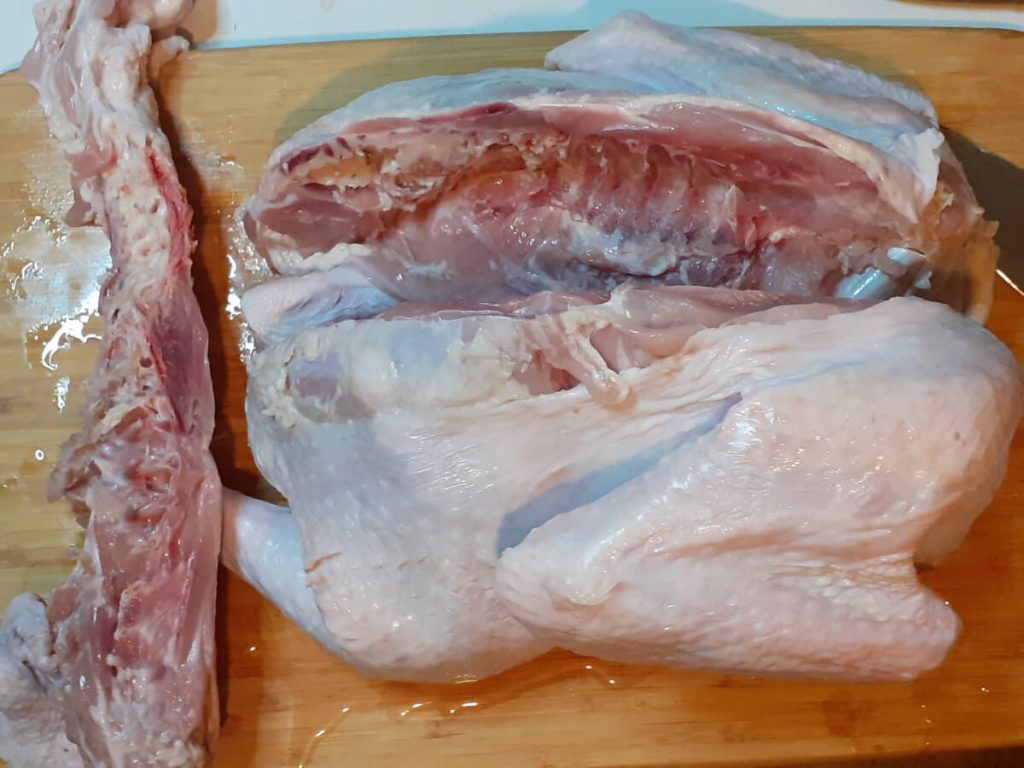
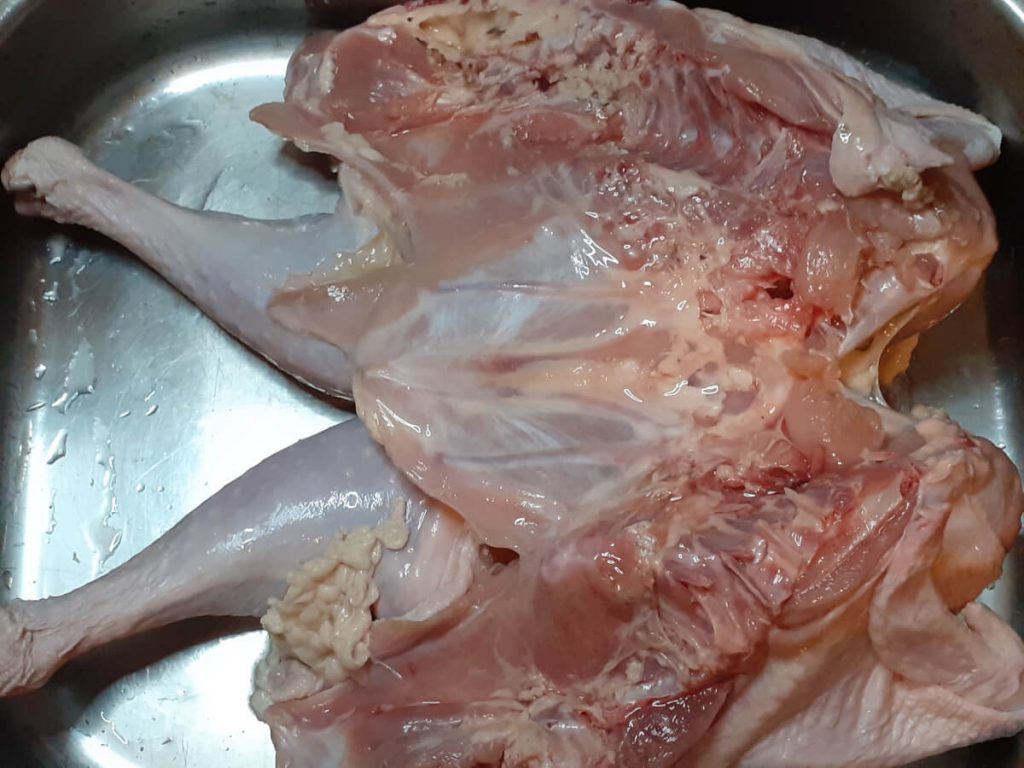
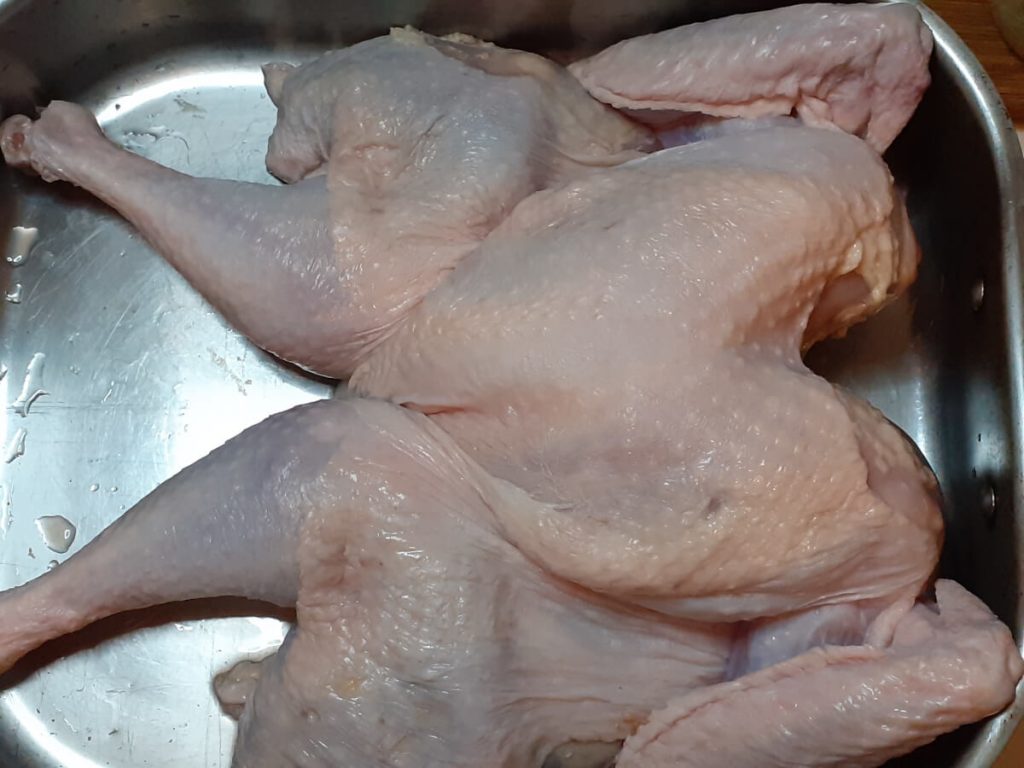
How to Butcher a Whole Chicken
Butchering a Whole Chicken can be done a few different ways. While the Quarters & Wings are pretty straight forwards, except for Quarters that may have the Backbone attached or not. The Breast can actually be butchered a few different ways, depending on how the Chicken pieces will be used.
First, start by sharpening your knife and removing the Butcher Twine. Slice between the Breast and Thighs to start separating the pieces into the Breast, Wing and Back Portion vs the Quarters.

Separate the Whole Chicken Quarters
Bend the Quarter back and chop through the spine to separate. Another way is to bend the Thigh bone back and chop at the joint all the way around, avoiding the Oysters and Backbone. I don’t really like Thighs without the Backbone, and so always chop it this way.

Chop right through the Backbone in half to separate the two Quarters. These will later be cleaned, trimmed and optionally the Legs separated.

How to Prepare Chicken Quarters
The Chicken doesn’t really require any cleaning except the Thigh piece. The Legs, Wings, Breasts are fine. The Thigh piece, however, has the backbone attached. There are internal organs in a pocket right beside the spine that you will want to clean out for better-tasting Chicken.
Run your thumb or a small spoon between the spine and thigh, squishing or scraping out the internal organs. It also needs to be trimmed up a bit of any excess skin and fat.
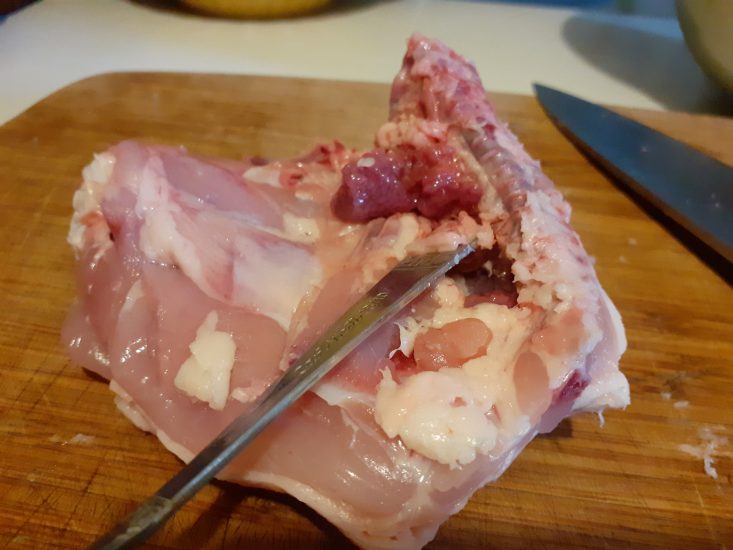
Depending on how the Quarters will be prepared or cooked you can leave them intact (Thighs & Legs) or chop between the joint to separate the Leg from the Thighs. If you flip the Quarter over skin side down, you will see a line of fat that separates the leg from the thigh. Slice between this fat line to separate. You can also feel where the joint is and slilce in between.
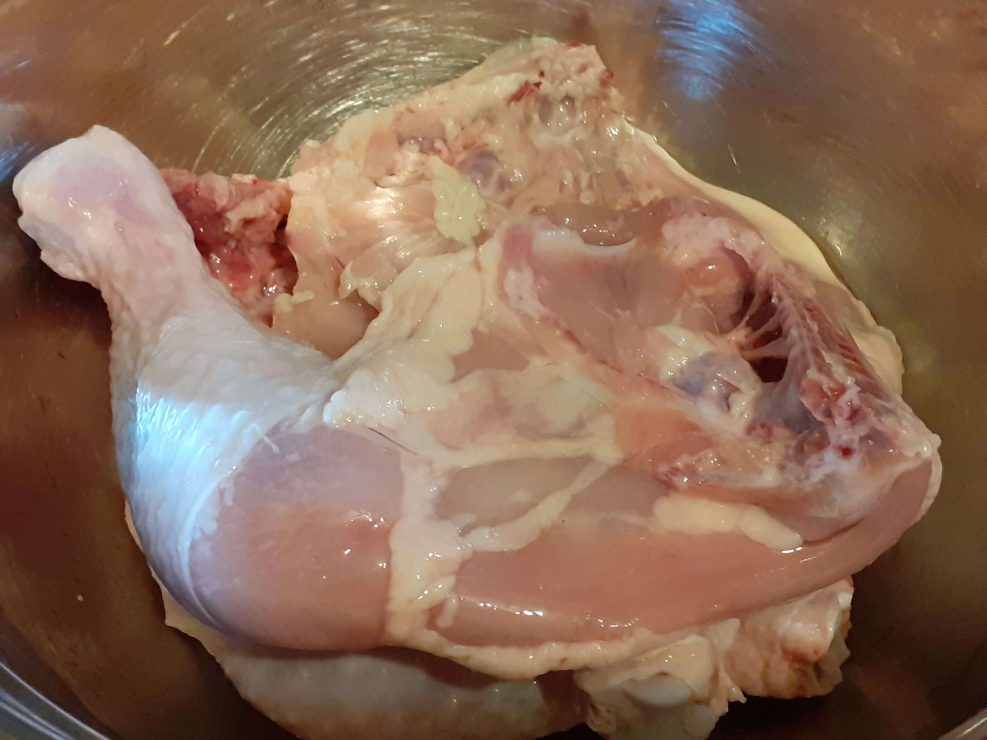
How to Debone Chicken Thighs
Chicken Quarters can be chopped to spearate the Thighs from the Legs and deboned sperately or the entire quarter deboned.

Remove the Backbone
Remove the Backbone if attached by slicing through on one side where the thighbone meets the backbone as close to the backbone as possible for maximum meat. Bend back to separate the Backbone from the Thigh Bone. Slice in between to separate, staying close to the backbone.
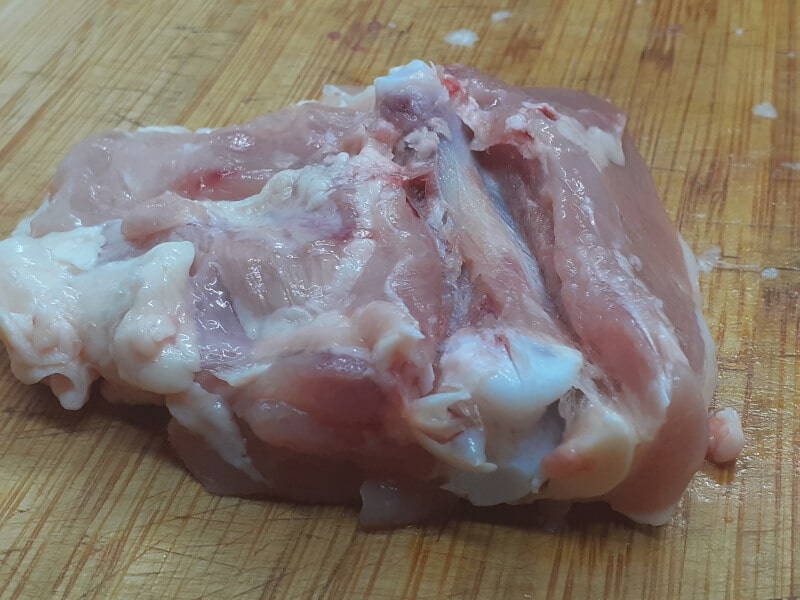
Exposing the bone
Carefully run your knife along the length and to the bone. Scrape the meat away from the bone. Make small slits on each side of the bone, exposing more of the thighbone.
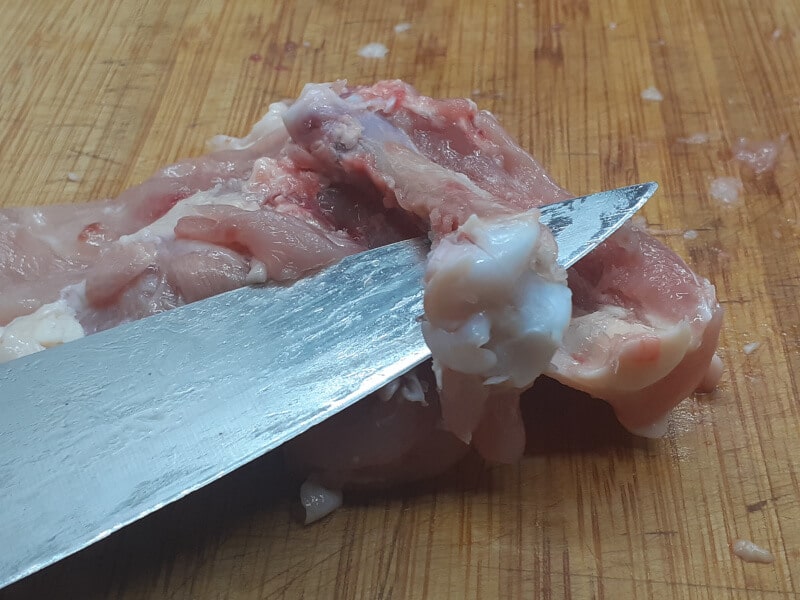
Free up the Thighbone
Insert the knife under the bone, but don’t slice through the other side. Slice against the bone towards the big knuckle to free it from the meat.

Removing the Bone
Scrape all the way around the bone, down to the end of the bone. Grasp it firmly and pull it away from the meat while slicing and scraping the meat.
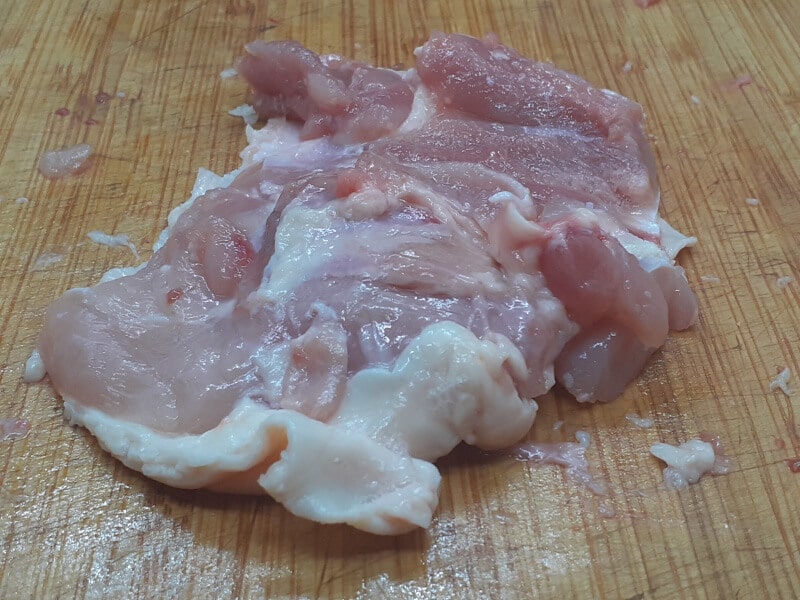
Clean up
Trim any excess fat or connective tissue from the thigh meat. Inspect the meat for any bone fragments left behind.
Separate the Wings
Bend the Wings Back until you hear a pop. Slice in between the joint to separate the Wings. The Wing Tips can be chopped at the joint and saved for Broth or included. The Wingette and Drumette can also be sliced between the joint to separate or left intact.

Separate the Backbone and Ribs
This is an older picture which I will have to update. But it shows the Backbone and Rib section chopped away from the Breast. These can be saved along with the Neck and any other trimmings for Broth. Just slice through the Ribs to remove.

Separate the Breast
This is where the Cuts can get interesting from keeping the Breast intact bone in or removed to chopping it into smaller pieces, including chopping the tip of the breast off before separating the Breast. In general the Breast can be flipped skin side down to chop in half right through the sternum.
The Bone can be left in or the Breast flipped, breast or skin side up, and sliced with the tip of the knife to separate the meat for boneless Chicken Breast, skin included or not.
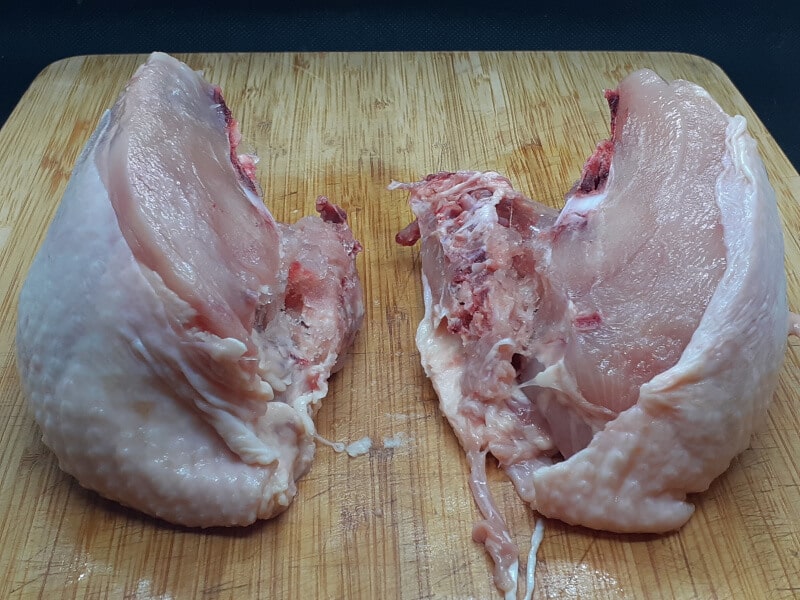
Separate the Chicken Tenderloins
The Tenderloin is attached under the Chicken Breast as a flap of meat that is barely attached and can be trimmed away or included with the Breast.
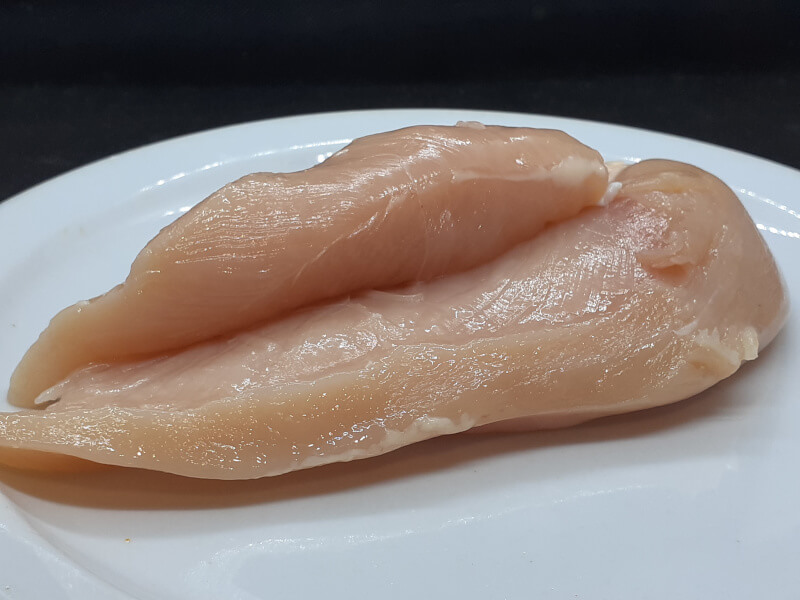
Whole Chicken Piece Count
A Whole Chicken can be chopped down into 8-12 pieces depending on how it will be used.
While the Wings & Quarters stay the same, yeilding 6 pieces altogether or 4, if wanting whole Chicken Quarters. The Breast can be cut in numerous ways to adjust the count and size depending on where the Chicken will be used or even just a preferential cut. Anywhere from 2 pieces to 6 pieces.

8 Piece Count
2 Legs, 2 Thighs, 2 Wings, 2 large Chicken Breasts.
I wouldn’t recommend deep-frying the breast of this size. But you can definitely debone the breast and cut for Big Crunch Sandwich or Chicken Popcorn. Or Cube it and save for Butter Chicken, Sweet & Sour Chicken Balls, Kebabs, etc…

9 Piece Count
2 Legs, 2 Thighs, 2 Wings, 2 medium Chicken Breasts, and 1 end piece of both Chicken Breasts as one piece.
This would be the same as the 8 cuts, but the end piece of both breasts is cut away as one piece. This can be deep-fried, but I still wouldn’t do the breast. Not that you can’t. It’s just my preference for Breading to Meat Ratio and Cook times. If you do want to deep-fry this cut. Then cut the end chicken breast piece closer to the center so that you end up with 3 Breast pieces about the same size.

10 Piece Count
2 Legs, 2 Thighs, 2 Wings, 4 smaller Chicken Breasts. Chicken Breasts are cut in half.
This is the cut I use if breaking down the breast for Big Crunch. The breast is cut into four. I debone and then slice in half to get 8 thin Breasts or 4 larger ones, pounded flat enough for the Big Crunch Sandwich.

11 Piece Count
2 Legs, 2 Thighs, 2 Wings, 4 Chicken Breasts. The end piece of both Breasts is cut off in 1 piece, then the Chicken Breast is cut in half.
This is one of my preferred cuts for Fried Chicken. I find you get an overall better experience with this cut from the breading to meat ratio and cook times as well. But this is just my preference. Cut the Chicken Breast so that you end up with 5 same size pieces.
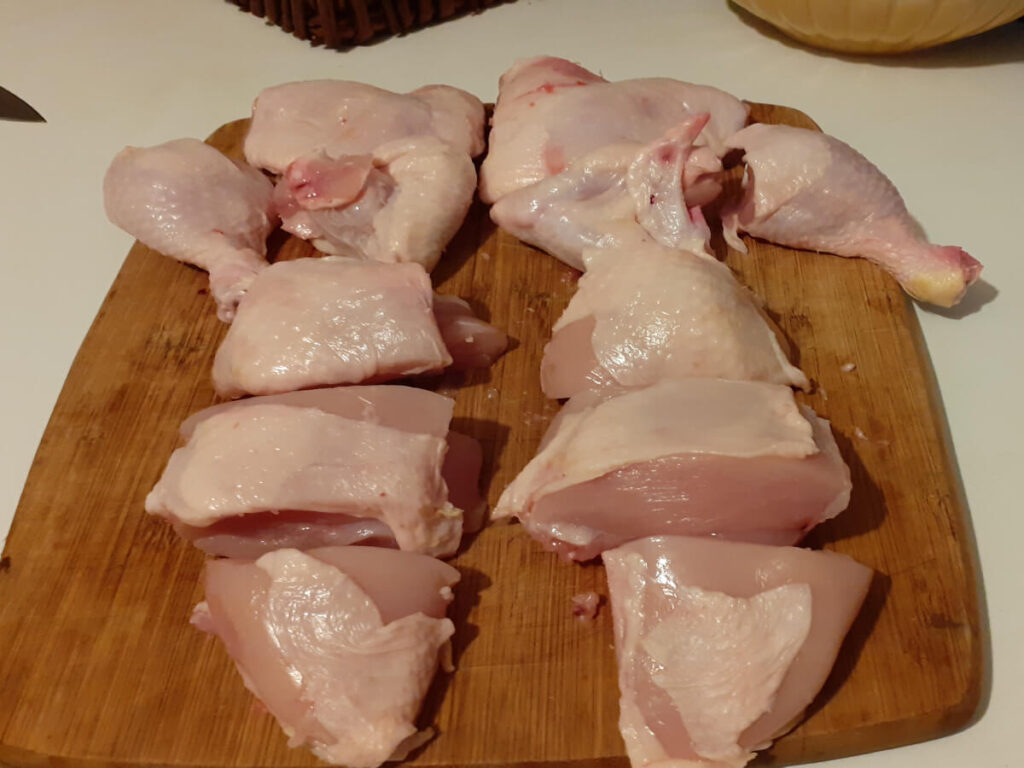
12 Piece Count
2 Legs, 2 Thighs, 2 Wings, 6 small Chicken Breasts. Each Breast is cut into 3.
I also use this cut for Fried Chicken. Sometimes I will use the 2 end pieces of the Breast to make Popcorn Chicken or Small Dice it and save/freeze it for other recipes.
How to remove Blood from Chicken
Sometimes very young Chicken is packaged and sold before the bones had sufficient time to develop, and this will cause the bones to leak out blood while cooking. The Chicken is still safe to eat, but it is very unappetizing, especially in Fried Chicken. With young Chicken, it can be very difficult to extract all the blood because it is deep in the bones and protected. The bones are dense enough to protect the blood, but not dense enough where it doesn’t contain much blood and leaks out when cooked.
Because of this, when picking out your fresh chicken, take a look at the bones and see if it is porous and contains a lot of blood. If it does, skip it and find a better Chicken.
Kosher Salt is used over the Chicken and refrigerated, which will draw the blood out. After some time, you will see pinkish to reddish liquid. That is the blood that has been drawn out.
Kosher Salt
I do this for my Fried Chicken if I end up with Chicken that is bloody. Once the Chicken is coated with Kosher Salt, about 1 Tbl per Whole Chicken. Mix the Chicken around, cover, and place in the fridge for a few hours or overnight for best results.
The next day, Fill the Chicken container with cold water and mix. Drain and repeat, ensuring that you get the Salt off. There will still be some salt attached to the Chicken, but most of it can be washed off.
Butchering a Whole Cooked Chicken
The same technique is used for breaking a Whole Chiken down whether it is cooked or not.
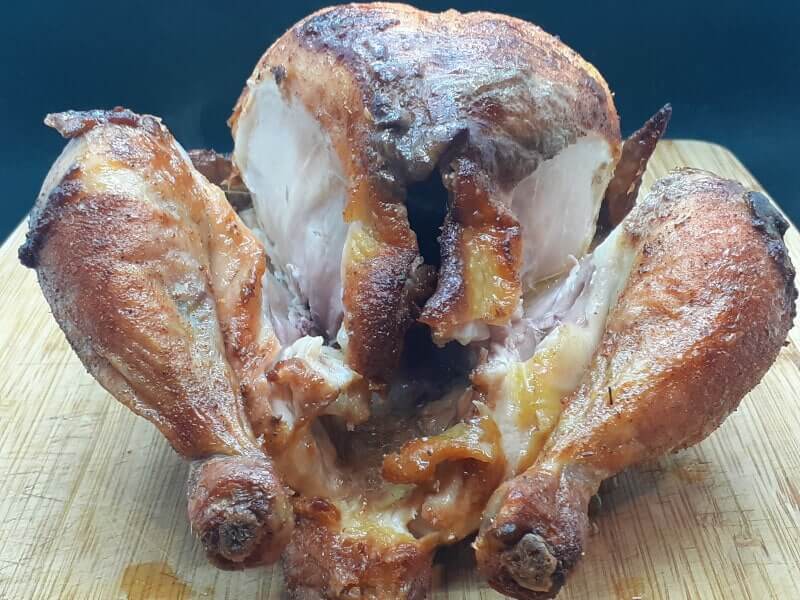

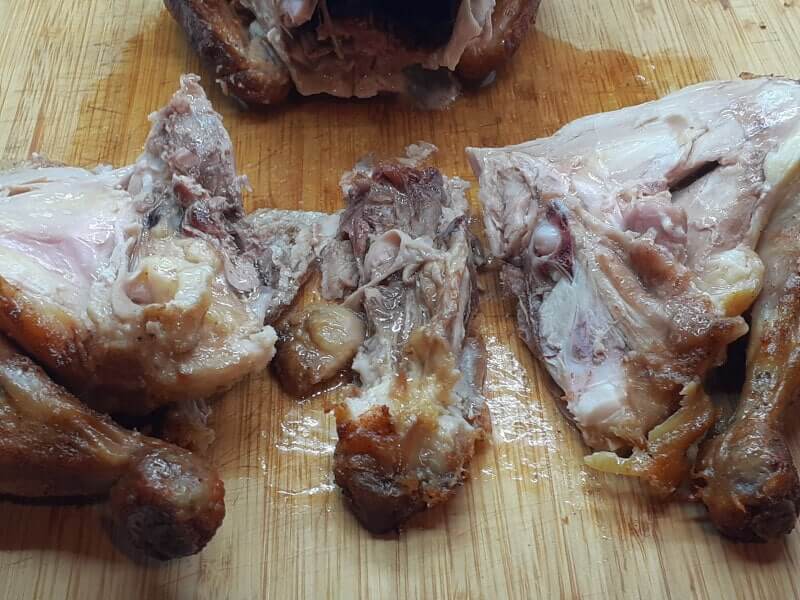
Either beside the Backbone through the Thigh Joint or chop right through the spine in half.

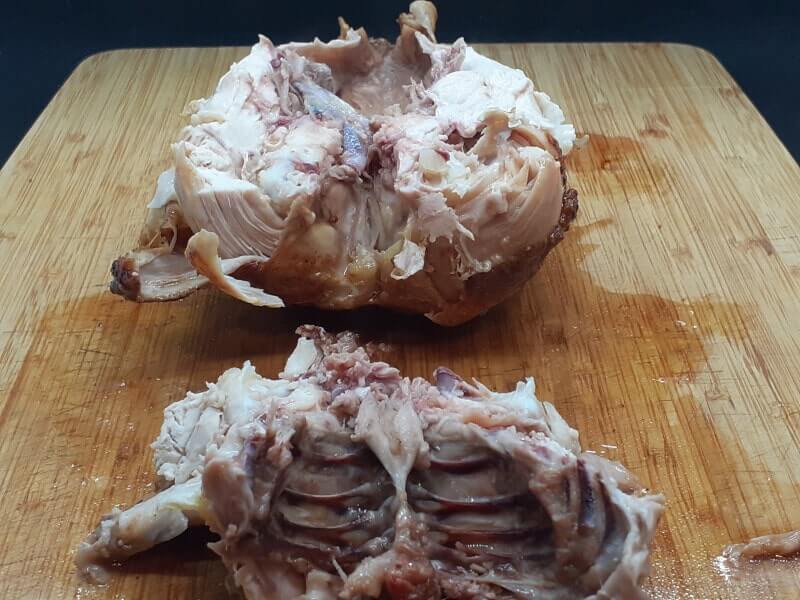

With just the Chicken Breast left, you can chop this a few different ways. For this example, we are choping the Tip of the breast off and then the breast in half right through the breast bone. For this it is better to flip the breast side down and chop through the breast bone this way.
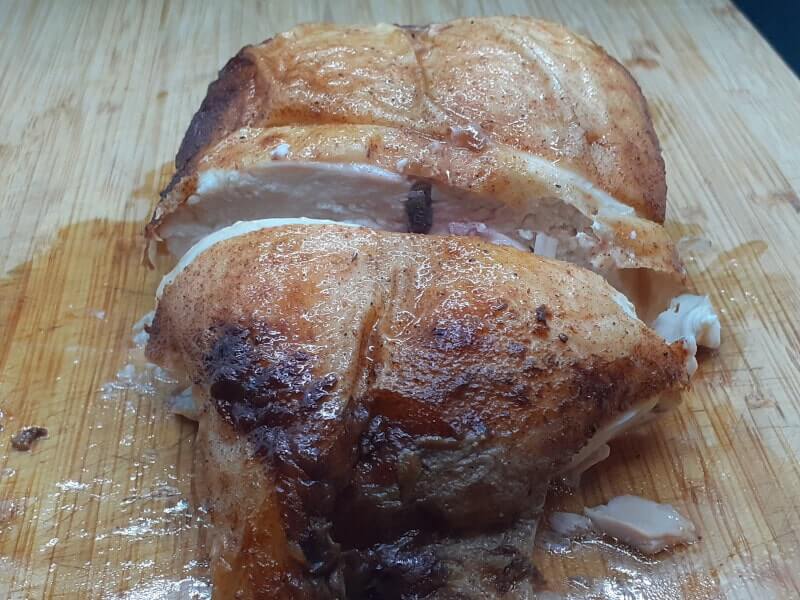
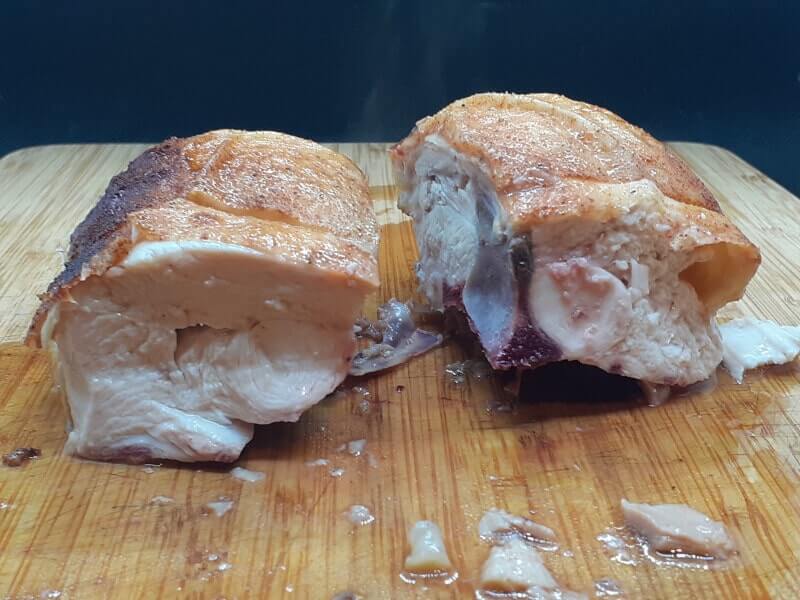

Once the Whole Chicken has been broken down into pieces. Arrange the pieces on a large Plate or presentatiom tray. For even fancier line the plate with Curly Parlsey and place the Chicken pieces on top.
Rendered Chicken Fat
Render Chicken Fat will elevate any Chicken Dish. Render Skin and Fat Trimmings to get a wonderful Fat that can be used for Searing or as the Fat component in Rice, Soups or Gravies. Any Trimmings can also be placed into freezer bag to render out later.
In some cases you may not want Chicken Skin on the Chicken pieces for certain recipes. That Skin can be sliced small and rendered out for searing. Just place it into a skillet over medium to medium low heat and cook until crispy brown. Scoop out and discard or season with Salt & Pepper to snack on.
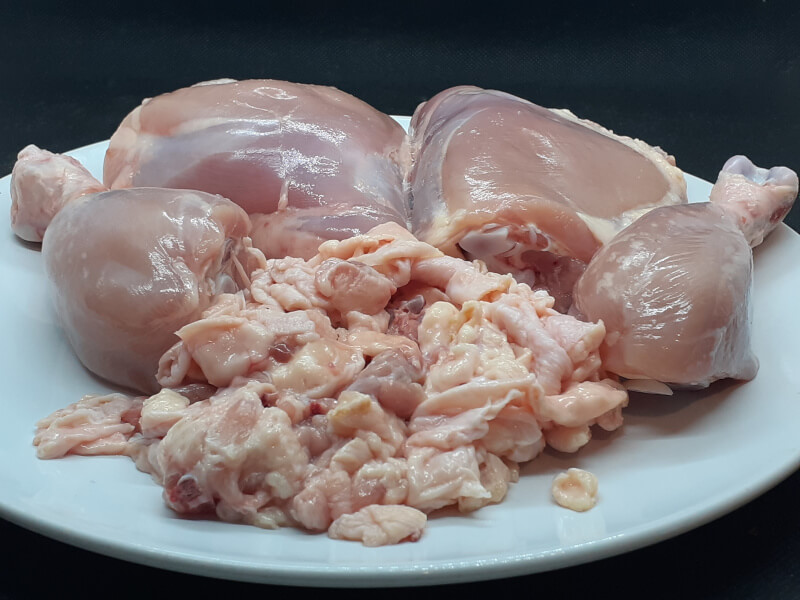
Practice makes perfect
At first, you’re not going to be sure what to do or be a bit awkward with it, and that’s okay. Just like with anything, after some time and practicing this, it will come to you with ease. Eventually, it will be nothing to break down a Chicken or Turkey. Whether that is raw Chicken or after cooking a whole Chicken the process is the same.
